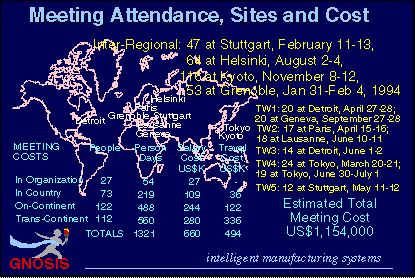 A major objective of the test case was to determine the feasibility, benefits
and problems of operating a large-scale international research project with
many partners. This section addresses the issues of coordination and
communication.
The main forms of communication between partners in the test case are shown in
Figure 7. The inter-regional and technical work package meetings allowed
partners to come to know one another, to exchange accounts of experience,
research capabilities and needs, and to develop plans and agree
responsibilities. Fax and telephone communication were used extensively to
coordinate ongoing activities. Researcher exchange was limited for reasons
already discussed, but what took place was significant in supporting technical
collaboration. Electronic mail was used between some 23 of the 31 partner
organizations, and mail list servers were set up at partner sites in Tokyo and
Stuttgart that supported work package and administrative coordination. Large
numbers of technical documents were exchanged at the meetings, and managing the
volume of these was a problem in its own right. As an experiment, all the
material from the first TW4 work package meeting in Tokyo was converted to
electronic form through optical character recognition and digitization, and a
300 page proceedings created in a uniform style. The document included
digitized movies of the software demonstrations given, and was made available
in paper and CD-ROM form.
A major objective of the test case was to determine the feasibility, benefits
and problems of operating a large-scale international research project with
many partners. This section addresses the issues of coordination and
communication.
The main forms of communication between partners in the test case are shown in
Figure 7. The inter-regional and technical work package meetings allowed
partners to come to know one another, to exchange accounts of experience,
research capabilities and needs, and to develop plans and agree
responsibilities. Fax and telephone communication were used extensively to
coordinate ongoing activities. Researcher exchange was limited for reasons
already discussed, but what took place was significant in supporting technical
collaboration. Electronic mail was used between some 23 of the 31 partner
organizations, and mail list servers were set up at partner sites in Tokyo and
Stuttgart that supported work package and administrative coordination. Large
numbers of technical documents were exchanged at the meetings, and managing the
volume of these was a problem in its own right. As an experiment, all the
material from the first TW4 work package meeting in Tokyo was converted to
electronic form through optical character recognition and digitization, and a
300 page proceedings created in a uniform style. The document included
digitized movies of the software demonstrations given, and was made available
in paper and CD-ROM form.

Figure 7 Main forms of communication in GNOSIS test case
The electronic mailing list servers played a very important role in
facilitating the GNOSIS test case coordination, and continue to operate as the
major means of ongoing collaboration between partners. Currently they are in
heavy use as the consortium prepares a long-term GNOSIS project proposal.
Figure 8 illustrates the operation of the servers. Partners anywhere in the
world sent electronic mail to mailing lists on machines in Tokyo or Stuttgart.
These machines then re-distributed it to all the other partners who had
registered with the mailing list. The Stuttgart machine also faxed the mail to
the few partners who did not have email facilities.

Figure 8 Electronic mailing list server operation
Mailing lists were set up for the entire project, each work package, the
Executive Committee, and for users of one of the tools distributed. Figure 9
shows the usage of the lists during the April-October 1993 period.

Figure 9 Electronic mailing list server usage
The expense of the time and travel involved in the meetings necessary to the
operation of the test case were of major concern. Figure 10 gives statistics on
the number of people involved from partners in the various regions, together
with an estimation of travel costs based on the actual meetings attended.

Figure 10 GNOSIS test case statistics of involvement and meeting cost
Contents,
Previous
Section,
Next
Section,
IMS
Page,
KSI
Page
gaines@cpsc.ucalgary.ca 1-Sep-94





